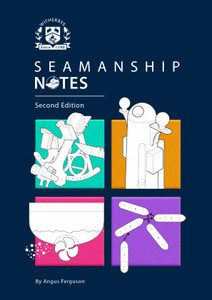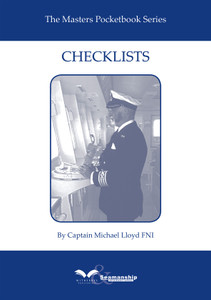
The book to get you through your exams and a reference for the rest of your career! This 1,300 page publication takes the traditional values of centuries of good seamanship and blends them with today’s reality. It is for seafarers at every level, covering ship types, handling and stability, onboard procedures and equipment, regulations, emergency response, etc.
A career at sea or in a marine related business understanding the practice of seamanship. In recent decades, shipping has moved at a tremendous pace and created a need for a new up to date manual. This book, which was ten years in the making, positions itself as a manual for the modern day seafarer in the 21st Century.
Preface
This book has taken ten years to prepare and, as a few have commented, it was probably in the planning long before then, whether I realised it or not.
A career at sea or in a marine-related business requires amassing a terrific volume of knowledge and the art and practice of seamanship is perhaps one of the most encyclopaedic job descriptions there is.
When I went to sea, almost 30 years ago, many would talk of days gone by when no self-respecting Chief Officer would be without his Seamanship Manual, and when I was about 12 or 13, I remember still the day my own father gave me his copy of ‘The Boatswain’s Manual’. In recent decades, shipping seems to have moved at a tremendous pace and it left me wondering whether it was possible to capture such a broad scope in a single publication that appeals to the forward thinking seafarer. This is exactly where this book positions itself – a manual for the modern day seafarer in the 21st Century.
This publication takes the traditional values of centuries of good seamanship and blends them with today’s reality and it seems appropriate that it is first published in our company’s 275th year.
By its very nature, this book is exceptionally broad in its scope and further detailed study of the topics covered in this book is available in the 600+ publications Witherbys has in print today. However, in owning this book, you have shown that you want to know and understand more about your industry, an industry that quietly keeps the world moving, carries over 90% of world trade and is set to almost double in volume over the next 20 years.
I wish you every success in your endeavours and always a safe voyage.
Iain Macneil
Managing Director
Witherby Publishing Group
Foreword
The term ‘seamanship’ is much misunderstood by those who are not required to practise the art. Seamanship is also hard to define succinctly as the breadth of knowledge, skills and experience the term encompasses take many a lifetime to acquire.
When I arrived aboard my first ship a little over forty years ago, the ships that made up the world’s merchant fleets, the technologies employed on board and the regulations that governed the industry, and indeed the seafarers themselves, bore little in common with today. However, despite all the technologies that connect ship and shore and keep communications links open at all times, the fact remains that, once a ship puts to sea, it is primarily dependent upon the actions of the master and crew to safely and efficiently execute the voyage, bringing profit to the owner whilst making sure all aboard return safe and well on completion. All must depend on each other, in a variety of circumstances; the ability to perform the broad range of tasks required safely and efficiently, whilst being fully aware of the associated hazards and mitigating measures, is in the broadest sense ‘seamanship’.
The technological advances seen today have led to the launching of more and more specialist ships, all requiring equally specialist knowledge to operate them. There is a danger that the rate of technological advance outpaces the ability of the industry to train competent mariners to operate the increasingly complex ships on which they serve. The need for continued professional development for mariners is inarguable, but this can be difficult to achieve when many ships cannot provide access to the online references enjoyed by most other industries, a problem that has yet to be universally solved. That said, traditional knowledge and skills are still required as it is a stark fact that mooring accidents, lifeboat launching and enclosed space entry continue to kill and injure the unwary, as they have for many decades.
The inclusion in this book of significant incidents in sufficient detail to allow the reader to extract and apply the learning is so valuable as, without doubt, poor decisions and behaviours contribute to far too many accidents at sea. This book provides a solid foundation of knowledge to all those operating, managing and manning today’s merchant fleet. I hope that 21st Century Seamanship will be a reference that is ready to hand on every ship and in every shipping company reference library.
David Cotterell
Director, OCIMF
June 2015
Chapter 1 General Cargo Ship Types
Chapter 2 Tankers
Chapter 3 Other Ship Types
Chapter 4 Offshore Marine Operations
Chapter 5 Machinery and Equipment
Chapter 6 Pilotage
Chapter 7 Ship Handling
Chapter 8 Anchorwork
Chapter 9 Tugs and Towing
Chapter 10 Mooring Operations and Safety
Chapter 11 Waterways, River Transits and Canals
Chapter 12 Preparing a Ship for Ice
Chapter 13 Non-Standard Operations
Chapter 14 Stood by New Builds
Chapter 15 Paints and Coatings
Chapter 16 Drydock
Chapter 17 Lay-up of Ships
Chapter 18 Heavy Weather
Chapter 19 Participating in SAR
Chapter 20 Oil Spills/Pollution
Chapter 21 Practical Aspects of Salvage
Chapter 22 Main Conventions and Codes
Chapter 23 Recent Regulations
Chapter 24 Certification and Endorsements
Chapter 25 Business and Chartering
Chapter 26 Conflict and Issues Affecting Shipping
Chapter 27 Fines for Ships and Ships’ Staff
Chapter 28 In Port and Alongside
Chapter 29 Shipboard Inspections
Chapter 30 Surveys and Classification
Chapter 31 Systems of Work
Chapter 32 Permit to Work
Chapter 33 Enclosed Space Entry
Chapter 34 Health
Chapter 35 Housekeeping on Board
Chapter 36 Ships’ Equipment and Maintenance
Chapter 37 Lifeboat Release Mechanisms
Chapter 38 Fire-fighting
Chapter 39 Shipboard Drills
Chapter 40 Accident Investigation
Chapter 41 Stability
Chapter 42 Damage Stability
Chapter 43 Hull Monitoring and Inspection
Chapter 44 Energy Efficiency
Chapter 45 Ship Recycling
Chapter 46 Traditional Seamanship
Chapter 47 Wires, Ropes, Chains, Shackles & Slings
Chapter 48 Cranes and Lifting Equipment
Chapter 49 Checklists
Chapter 50 Tsunamis and Marine Phenomena
Index
Witherbys
Witherbys titles are developed using scripts developed by technical experts that are peer reviewed within work groups. Typically, they seek to improve understanding of the regulations, recommendations and guidelines issued by Industry.
Witherbys staff have significant expertise in the fields of navigation and hazardous cargoes as well as in the presentation of complex subjects in a graphic and easy to understand manner.
- Number of Pages:
- 1300
- ISBN:
- 9781856096324
- Published Date:
- August 2015
- Binding Format:
- Paperback
- Book Height:
- 235 mm
- Book Width:
- 160 mm
- Weight:
- 2.2 kg
- Author:
Witherbys
- Preview:
- Yes
- Product Catalogue:
- Definitive Guides PDF






